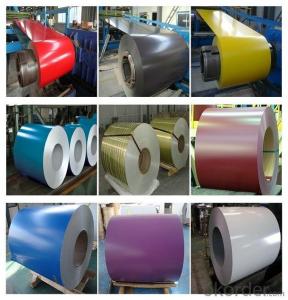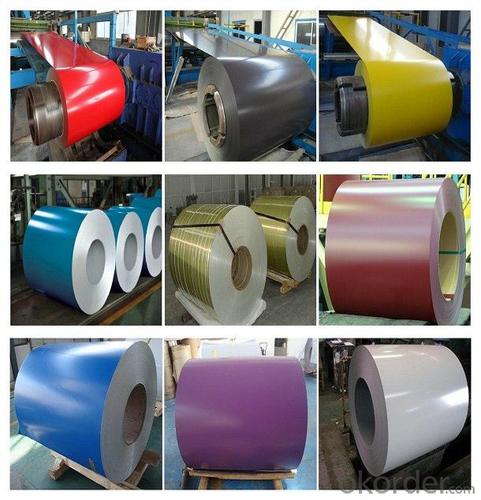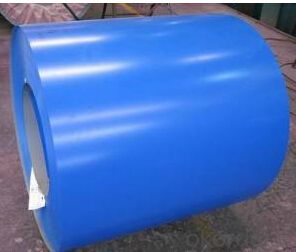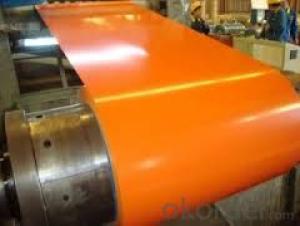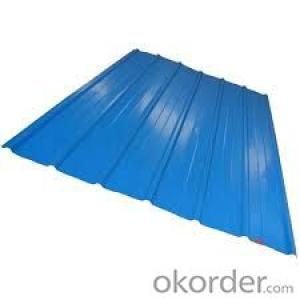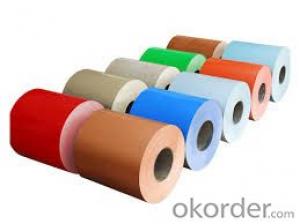Prepainted Galvanized/Aluzing Steel coils(PPGI) for Roofings
- Loading Port:
- Shanghai
- Payment Terms:
- TT OR LC
- Min Order Qty:
- 50 m.t.
- Supply Capability:
- 10000 m.t./month
OKorder Service Pledge
OKorder Financial Service
You Might Also Like
Specification
Product Details
Basic Info.
Model NO.:G550, FULL HARD, SGHC
Type:Steel Coil
Standard:ASTM, GB, JIS
Certification:ISO, SGS, BV
Surface Treatment:Coated
Technique:Hot Rolled
Special Use:High-strength Steel Plate
Base Metal:Galvanized or Galvalume Steel
Width:914/1000/1200/1219/1220/1250mm
Thickness:0.16-1.2mm
Zinc-Coating:Z50-150G/M2 or Az40-100G/M2
Top Side Painting:15-25 Micron
Back Side Painting:5-8 Micron
Colour:Ral Standard or According to Customers′ Requirment
Coil Weight:3-6 Mt
Coil ID:508/610 Mm
Export Markets:North America, South America, Eastern Europe, Southeast Asia, Africa, Mid East, Eastern Asia
Additional Info.
Packing:Seaworthy Packing
Standard:0.135-1.2MM
Origin:China, Shandong
HS Code:72107000
Production Capacity:180000mt
Product Description:
1. Standard: AISI, ASTM, BS, DIN, GB, JIS, ASTM, JIS, GB
2. Steel Grade: DX51D, SGCC, SGCH, SPCC, SPCD, DC01, ST12, ST13, Q195, 08AL
3. Thickness: 0.13-0.5mm
4. Width: 600-1250mm
5. Length: Up to The Thickness or as require
6. Spangle: Zero, Mini, Regular, Big, Skin Pass
7. Audited Certificates: BV, SGS, ISO, CIQ
8. Zinc Coating: 40g-200g
9. Surface: Chromated, dry/oiled, Cr3 treated anti-finger
10. Package: Standard exporting package (or as required)
11. ID: 508/610mm
Specification:
| commodity | Color Coated Steel Coil (PPGI/ PPGL) |
| Techinical Standard: | JIS G3302-1998, EN10142/10137, ASTM A653 |
| grade | TSGCC, TDX51D / TDX52D / TS250, 280GD |
| Types: | For general / drawing use |
| Base metal | galvanized, galvalume, cold rolled steel |
| Thickness | 0.14-1.0mm(0.16-0.8mm is the most advantage thickness) |
| Width | 610/724/820/914/1000/1200/1219/1220/1250mm |
| Type of coating: | PE, SMP, PVDF |
| Zinc coating | Z60-150g/m2 or AZ40-100g/m2 |
| Top painting: | 5 mic. Primer + 15 mc. R. M. P. |
| Back painting: | 5-7 mic. EP |
| Color: | According to RAL standard |
| ID coil | 508mm / 610mm |
| Coil weight: | 4--8MT |
| Package: | Properly packed for ocean freight exportation in 20' ' containers |
| Application: | Industrial panels, roofing and siding for painting / automobile |
| Price terms | FOB, CFR, CIF |
| Payment terms | 20%TT in advance+80% TT or irrevocable 80%L/C at sight |
| delivery time | 25 days after recepit of 20% TT |
| Remarks | Insurance is all risks |
| MTC 3.1 will be handed on with shipping documents | |
| We accept SGS certificatation test |
Details of Type:
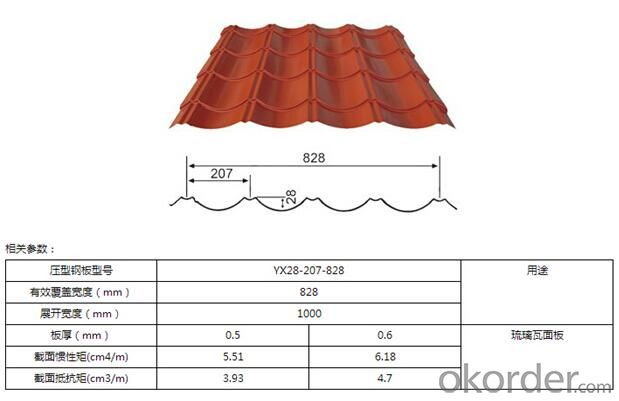

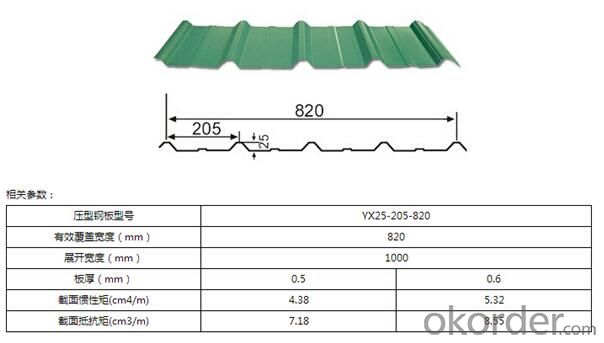
FAQ:
1.What's your MOQ?
25MT, it is for one container.
2.Do you have QC teams?
Yeah, sure, our QC team is very important, they will keep the quality control for our products.
3. What's your normal delivery time?
Our delivery time about 10-20days for standard sizes, if you have other requirements like hardness and width ,it is about 20-40days. But don't worry ,we also try our best for the delivery time ,because time longer and our cost is higher.
4.Are the products tested before shipping?
Yes, all of our PPGI and GI was qualified before shipping. We test every batch every day.
- Q: What are the different types of steel processing equipment for coils?
- There are several types of steel processing equipment for coils, including slitters, cut-to-length lines, leveling machines, coil cars, and stackers. Slitters are used to cut wide coils into narrower strips, while cut-to-length lines can cut coils into specific lengths. Leveling machines are used to flatten and remove any imperfections on the surface of the coils. Coil cars are used to transport the coils within the processing facility, and stackers are used to neatly stack the coils for storage or transportation.
- Q: How do steel coils contribute to the HVAC industry?
- Steel coils are an integral component of the HVAC (Heating, Ventilation, and Air Conditioning) industry and play a crucial role in the functioning and efficiency of HVAC systems. These coils are typically made from high-quality steel, such as stainless steel or galvanized steel, which ensures durability and resistance to corrosion. One of the main ways steel coils contribute to the HVAC industry is by facilitating heat transfer. HVAC systems use coils to transfer heat between the air and a refrigerant. In air conditioning units, for example, the evaporator coil absorbs heat from the indoor air, while the condenser coil releases heat to the outside air. The steel coils in these units provide a large surface area for efficient heat exchange, enabling the cooling or heating of the air as required. Moreover, steel coils also contribute to the overall energy efficiency of HVAC systems. By maximizing heat transfer, these coils allow HVAC systems to operate at optimal performance levels while consuming less energy. This not only helps reduce energy costs for users but also makes HVAC systems more environmentally friendly by minimizing energy consumption and greenhouse gas emissions. Steel coils in HVAC systems also contribute to the quality of indoor air. As air passes over the coils, any impurities, such as dust, dirt, or mold, can accumulate on the coil's surface. Regular maintenance and cleaning of the coils are essential to prevent the buildup of contaminants that could negatively impact air quality. Properly maintained steel coils ensure clean and healthy indoor air, which is particularly important for commercial buildings, hospitals, and other spaces where air quality is crucial. In addition to their heat transfer and energy efficiency capabilities, steel coils also provide durability and longevity to HVAC systems. Steel is a strong and resilient material that can withstand high temperatures, pressure, and environmental stressors. By using steel coils, HVAC systems can operate reliably and efficiently for extended periods, reducing the need for frequent repairs or replacements. Overall, steel coils are a vital component of the HVAC industry. They enable efficient heat transfer, improve energy efficiency, enhance indoor air quality, and provide durability to HVAC systems. Without steel coils, the performance and effectiveness of HVAC systems would be significantly compromised, making them an indispensable element of the HVAC industry.
- Q: How is the critical temperature of structural steel affected by fireproofing? What temperatures can fireproofed structural steel withstand?
- mix the fire retardant with cement, let it harden fast to superstructure. this will create better stability and will not be dislodged in case of impact.
- Q: How are steel coils used in the production of metal roofing?
- Steel coils are used in the production of metal roofing by being fed through a series of machines that shape, cut, and coat the steel to create the final roofing product. The coils are uncoiled and flattened, then formed into the desired profile using roll forming machines. The formed sheets are then cut into specific lengths and coated with protective layers to enhance durability and corrosion resistance. These coated steel sheets are then packaged and shipped to construction sites for installation as metal roofing.
- Q: Stains tends to leave on the stainless steel microwave oven and its very hard to clean off the stain (brownish stain) please suggest the best way to remove it.
- i am not sure what country you are in but in australia we have this stuff called easy off bam and if you leave it on for half an hour then wipe it off that does the trick. If that option is not available, I know it sounds silly, but try either toothpaste or some lemon juice mixed with bicarbonate of soda. Good Luck i hope that helps you some :)
- Q: What are the applications of steel coils in the aerospace industry?
- The aerospace industry relies heavily on steel coils for various purposes. One important application is in the manufacturing of aircraft structures. Steel coils are commonly used to fabricate wing spars, fuselage frames, and landing gear, as they possess high strength and durability necessary to withstand heavy loads and extreme conditions. Another significant use of steel coils in the aerospace industry is in the production of engine components, specifically turbine blades. These blades experience high temperatures and rotational forces, making it crucial to utilize steel coils due to their excellent heat resistance and mechanical properties. This ensures the reliability and performance of aircraft engines. Steel coils also find utilization in the production of fasteners and connectors necessary for securely joining different parts of an aircraft. Bolts, nuts, and rivets made from steel coils are essential for maintaining the structural integrity and safety of the aircraft. These fasteners need to possess high tensile strength and corrosion resistance. Furthermore, steel coils are employed in the production of fuel tanks and hydraulic systems. The weldability and formability of steel allow for the efficient fabrication of these complex structures. Steel coils can be shaped into various sizes and configurations, providing flexibility in designing fuel tanks and hydraulic components that meet specific requirements. In conclusion, steel coils are indispensable in the aerospace industry. Their use in aircraft structures, engine components, fasteners, and fuel tanks highlights their versatility and reliability. The exceptional strength, durability, heat resistance, and formability of steel make it the preferred material for various aerospace applications, ultimately ensuring the safety and performance of aircraft.
- Q: I'm wondering if steel casings are bad for a 1911. I know that an AK-47 will eat up steel casings all day long, but steel casings are bad for, and can be hard on an AR-15. I only have brass for my AR and that will never change. I'm curious as to how a 1911 fairs with steel casings. Is it bad for the gun or does it not matter? I'm asking because steel cased rounds seem to be the only readily available ammo these days. Thanks
- This better placed in the hunting section of sports. That is the area for gun questions. I've never used that Russian stuff in my guns. I would stick with brass or Aluminum Blaser ammo.
- Q: How are steel coils used in the production of fencing materials?
- Steel coils are used in the production of fencing materials by being unwound and flattened to create the wire used for fencing. The steel wire is then further processed and shaped into different forms, such as chain link or barbed wire, to meet specific fencing needs.
- Q: gigantic navy ships made of steel float, why??
- Believe it or not - A steel boat floats for the exact same reason all boats float. And the very best - easy to understand explanation of this (with pictures) is at the link below.
- Q: Does Steel Cut Oatmeal have the same health benefits as Old Fashioned Oatmeal? What is the difference in processing?
- Steel Cut Oats Steel-cut oats are whole oat kernels cut into small chunks rather than being smashed flat as in oatmeal. This gives the oats more of a chew texture and also slows both cooking time and digestion time. That means that they have a lower glycemic index and are thus preferable for increasing satiety, lowering the insulin response to the meal, and keeping blood sugar levels from peaking. This also results in delaying hunger so a person is less likely to snack or get overly hungry before the next meal. Here is how I like to cook oats for breakfast. Ingredients 1/2 cup Dry steel cut oats 1 cup Water (You may want a little more than a cup, experiment to your liking) 2 T Raisins (optional or replace with chopped dried apricots etc.) 2 T Ground flax meal (optional, but high in healthy n-3 fatty acids and fiber) Salt to your taste (try Lite salt to lower sodium intake) 2T Sunflower seeds or almonds 1 cup Fresh berries or a banana Directions Heat water to a boil. While water is heating, add the salt, raisins, and flax meal. When the water boils, add the steel cut oats. Stir once. Turn heat down to simmer and cook covered for 7-8 minutes. Provides two small servings. Double for large servings or small servings for 4 people. Serve and eat while hot. Add soy milk or low fat milk. Slice fresh fruit on top to add extra flavor. My wife likes banana slices. I like fresh berries, peaches, or sugar free applesauce. For extra crunch sprinkle almonds or sunflower seeds on top.
Send your message to us
Prepainted Galvanized/Aluzing Steel coils(PPGI) for Roofings
- Loading Port:
- Shanghai
- Payment Terms:
- TT OR LC
- Min Order Qty:
- 50 m.t.
- Supply Capability:
- 10000 m.t./month
OKorder Service Pledge
OKorder Financial Service
Similar products
Hot products
Hot Searches
Related keywords
